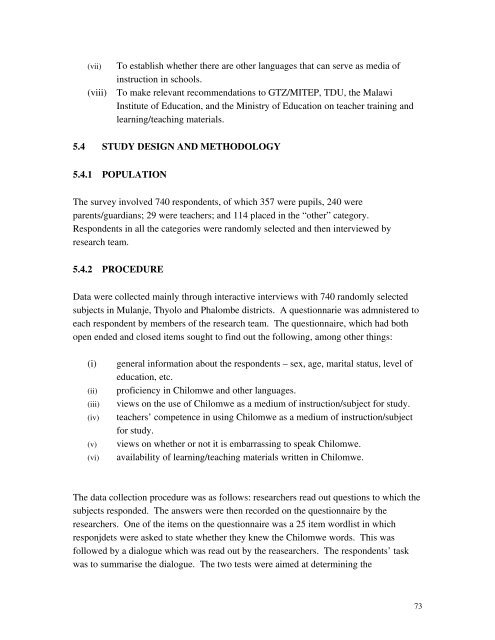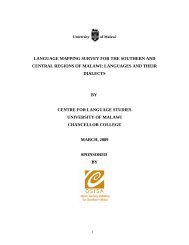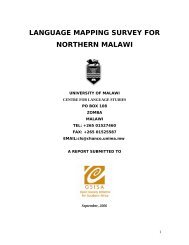SOCIOLOLINGUISTIC SURVEYS - Centre for Language Studies
SOCIOLOLINGUISTIC SURVEYS - Centre for Language Studies
SOCIOLOLINGUISTIC SURVEYS - Centre for Language Studies
You also want an ePaper? Increase the reach of your titles
YUMPU automatically turns print PDFs into web optimized ePapers that Google loves.
(vii)<br />
(viii)<br />
To establish whether there are other languages that can serve as media of<br />
instruction in schools.<br />
To make relevant recommendations to GTZ/MITEP, TDU, the Malawi<br />
Institute of Education, and the Ministry of Education on teacher training and<br />
learning/teaching materials.<br />
5.4 STUDY DESIGN AND METHODOLOGY<br />
5.4.1 POPULATION<br />
The survey involved 740 respondents, of which 357 were pupils, 240 were<br />
parents/guardians; 29 were teachers; and 114 placed in the “other” category.<br />
Respondents in all the categories were randomly selected and then interviewed by<br />
research team.<br />
5.4.2 PROCEDURE<br />
Data were collected mainly through interactive interviews with 740 randomly selected<br />
subjects in Mulanje, Thyolo and Phalombe districts. A questionnarie was admnistered to<br />
each respondent by members of the research team. The questionnaire, which had both<br />
open ended and closed items sought to find out the following, among other things:<br />
(i)<br />
(ii)<br />
(iii)<br />
(iv)<br />
(v)<br />
(vi)<br />
general in<strong>for</strong>mation about the respondents – sex, age, marital status, level of<br />
education, etc.<br />
proficiency in Chilomwe and other languages.<br />
views on the use of Chilomwe as a medium of instruction/subject <strong>for</strong> study.<br />
teachers’ competence in using Chilomwe as a medium of instruction/subject<br />
<strong>for</strong> study.<br />
views on whether or not it is embarrassing to speak Chilomwe.<br />
availability of learning/teaching materials written in Chilomwe.<br />
The data collection procedure was as follows: researchers read out questions to which the<br />
subjects responded. The answers were then recorded on the questionnaire by the<br />
researchers. One of the items on the questionnaire was a 25 item wordlist in which<br />
responjdets were asked to state whether they knew the Chilomwe words. This was<br />
followed by a dialogue which was read out by the reasearchers. The respondents’ task<br />
was to summarise the dialogue. The two tests were aimed at determining the<br />
73





